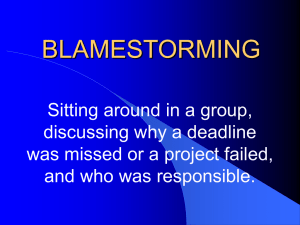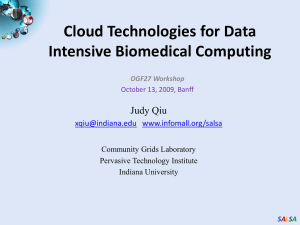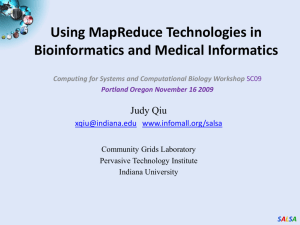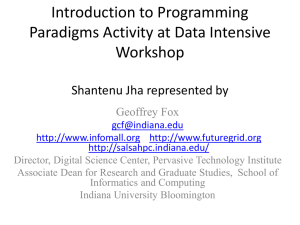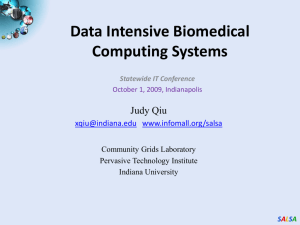Computational Methods for Large Scale DNA Data Analysis Judy Qiu
advertisement
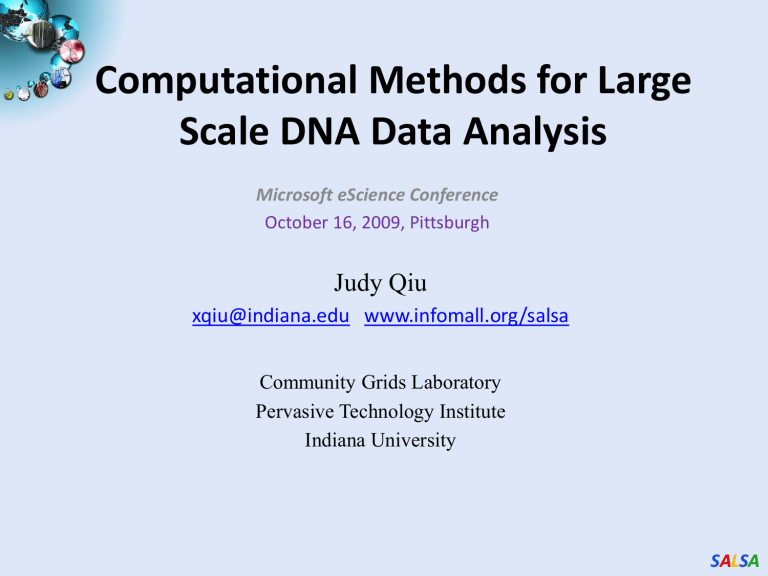
Computational Methods for Large Scale DNA Data Analysis Microsoft eScience Conference October 16, 2009, Pittsburgh Judy Qiu xqiu@indiana.edu www.infomall.org/salsa Community Grids Laboratory Pervasive Technology Institute Indiana University SALSA Collaborators in SALSA Project Microsoft Research Indiana University Technology Collaboration SALSA Technology Team Azure (Clouds) Dennis Gannon Roger Barga Dryad (Cloud Runtime) Christophe Poulain CCR (Threading) George Chrysanthakopoulos DSS (Services) Henrik Frystyk Nielsen Community Grids Lab and UITS RT – PTI Geoffrey Fox Judy Qiu Scott Beason Jaliya Ekanayake Thilina Gunarathne Jong Youl Choi Yang Ruan Seung-Hee Bae Hui Li Saliya Ekanayake Thilina Gunarathne Applications Bioinformatics, CGB Haixu Tang, Mina Rho, Peter Cherbas, Qunfeng Dong IU Medical School Gilbert Liu Demographics (Polis Center) Neil Devadasan Cheminformatics David Wild, Qian Zhu Physics CMS group at Caltech (Julian Bunn) SALSA Data Intensive (Science) Applications Applications Biology: Expressed Sequence Tag (EST) sequence assembly (CAP3) Biology: Pairwise Alu sequence alignment (SW) Health: Correlating childhood obesity with environmental factors Cheminformatics: Mapping PubChem data into low dimensions to aid drug discovery Data mining Algorithm Clustering (Pairwise , Vector) MDS, GTM, PCA, CCA Visualization PlotViz Cloud Technologies Classic HPC (MapReduce, Dryad, Hadoop) MPI, Threading FutureGrid/VM (A high performance grid test bed that supports new approaches to parallel, Grids and Cloud computing for science applications) Bare metal (Computer, network, storage) SALSA FutureGrid Architecture SALSA Cluster Configurations Feature GCB-K18 @ MSR iDataplex @ IU Tempest @ IU CPU Intel Xeon CPU L5420 2.50GHz Intel Xeon CPU L5420 2.50GHz Intel Xeon CPU E7450 2.40GHz # CPU /# Cores per node 2/8 2/8 4 / 24 Memory 16 GB 32GB 48GB # Disks 2 1 2 Network Giga bit Ethernet Giga bit Ethernet Giga bit Ethernet / 20 Gbps Infiniband Operating System Windows Server Enterprise - 64 bit Red Hat Enterprise Linux Server -64 bit Windows Server Enterprise - 64 bit # Nodes Used 32 32 32 256 768 Total CPU Cores Used 256 DryadLINQ Hadoop/ Dryad / MPI DryadLINQ / MPI SALSA Cloud Computing: Infrastructure and Runtimes • Cloud infrastructure: outsourcing of servers, computing, data, file space, etc. – Handled through Web services that control virtual machine lifecycles. • Cloud runtimes: tools (for using clouds) to do data-parallel computations. – Apache Hadoop, Google MapReduce, Microsoft Dryad, and others – Designed for information retrieval but are excellent for a wide range of science data analysis applications – Can also do much traditional parallel computing for data-mining if extended to support iterative operations – Not usually on Virtual Machines SALSA Data Intensive Architecture Instruments Database Database Database Files Files Files Database Database Database Database Database Database Files Files Files Database Database Database User Data Users Initial Processing Higher Level Processing Such as R PCA, Clustering Correlations … Maybe MPI Visualization User Portal Knowledge Discovery Prepare for Viz MDS SALSA MapReduce “File/Data Repository” Parallelism Instruments Map = (data parallel) computation reading and writing data Reduce = Collective/Consolidation phase e.g. forming multiple global sums as in histogram Communication via Messages/Files Disks Map1 Map2 Map3 Computers/Disks Reduce Portals /Users SALSA Alu Sequencing Workflow • Data is a collection of N sequences – 100’s of characters long – These cannot be thought of as vectors because there are missing characters – “Multiple Sequence Alignment” (creating vectors of characters) doesn’t seem to work if N larger than O(100) • First calculate N2 dissimilarities (distances) between sequences (all pairs) • Find families by clustering (much better methods than Kmeans). As no vectors, use vector free O(N2) methods • Map to 3D for visualization using Multidimensional Scaling MDS – also O(N2) • N = 50,000 runs in 10 hours (all above) on 768 cores • Our collaborators just gave us 170,000 sequences and want to look at 1.5 million – will develop new “fast multipole” algorithms! SALSA Gene Family from Alu Sequencing 1250 million distances 4 hours & 46 minutes • Calculate pairwise distances for a collection of genes (used for clustering, MDS) • O(N^2) problem • “Doubly Data Parallel” at Dryad Stage • Performance close to MPI • Performed on 768 cores (Tempest Cluster) 20000 18000 DryadLINQ 16000 MPI 14000 12000 10000 8000 Processes work better than threads when used inside vertices 100% utilization vs. 70% 6000 4000 2000 0 35339 50000 SALSA Hadoop/Dryad Model Upper triangle 0 0 0 (0,d-1) 0 (0,d-1) D 1 D-1 1 0 (0,2d-1) (0,d-1) D+1 (0,d-1) (d,2d-1) 2 (d,2d-1) (d,2d-1) ((D-1)d,Dd-1) (0,d-1) .. 1 0 D-1 D-1 DryadLINQ vertices DD-1 2 Blocks in lower triangle are not calculated directly File I/O File I/O .. .. V V DryadLINQ vertices 1 0 1T 1 2T DD-1 File I/O V .. DD-1 ((D-1)d,Dd-1) ((D-1)d,Dd-1) V V V V .. 2 Blocks in upper triangle NxN matrix broken down to DxD blocks Each D consecutive blocks are merged to form a set of row blocks each with NxD elementsprocess has workload of NxD elements Block Arrangement in Dryad and Hadoop Execution Model in Dryad and Hadoop Need to generate a single file with full NxN distance matrix SALSA SALSA SALSA Pairwise Clustering 30,000 Points on Tempest 6 Clustering by Deterministic Annealing 5 MPI 4 Parallel Overhead 3 2 Thread Thread Thread Thread 1 MPI Thread Thread 0 1 2 4 4 4 8 8 8 8 8 8 8 16 16 16 16 16 24 32 32 48 48 48 48 48 64 64 64 64 96 96 128 128 192 288 384 384 480 576 672 744 Parallelism MPI -1 Thread MPI SALSA Dryad versus MPI for Smith Waterman Performance of Dryad vs. MPI of SW-Gotoh Alignment Time per distance calculation per core (miliseconds) 7 6 Dryad (replicated data) 5 Block scattered MPI (replicated data) Dryad (raw data) 4 Space filling curve MPI (raw data) Space filling curve MPI (replicated data) 3 2 1 0 0 10000 20000 30000 40000 50000 60000 Sequeneces Flat is perfect scaling SALSA Dryad Scaling on Smith Waterman Time per distance calculation per core (milliseconds) DryadLINQ Scaling Test on SW-G Alignment 7 6 5 4 3 2 1 0 288 336 384 432 480 528 576 624 672 720 Cores Flat is perfect scaling SALSA Dryad for Inhomogeneous Data 1350 Mean Length 400 Total Time (s) Time (ms) 1300 1250 Computation 1200 1150 Sequence Length Standard Deviation 1100 0 50 100 150 200 250 Standard Deviation of sequence lengths 300 350 Flat is perfect scaling – measured on Tempest SALSA Hadoop/Dryad Comparison Inhomogeneous Data 1800 Time Dryad 1700 1600 Hadoop 1500 Mean Length 400 1400 1300 1200 0 50 100 150 200 250 300 350 Sequence Length Standard Deviation Dryad with Windows HPCS compared to Hadoop with Linux RHEL on IDataplex SALSA Hadoop/Dryad Comparison “Homogeneous” Data 0,012 Time per Alignment (ms) Dryad 0,01 0,008 Hadoop 0,006 0,004 0,002 0 30000 35000 40000 45000 50000 55000 Number of Sequences Dryad with Windows HPCS compared to Hadoop with Linux RHEL on Idataplex Using real data with standard deviation/length = 0.1 SALSA Block Dependence of Dryad SW-G Processing on 32 node IDataplex Dryad Block Size D Time to partition data Time to process data Time to merge files Total Time 128x128 64x64 32x32 1.839 2.224 2.224 30820.0 32035.0 39458.0 60.0 60.0 60.0 30882.0 32097.0 39520.0 Smaller number of blocks D increases data size per block and makes cache use less efficient Other plots have 64 by 64 blocking SALSA CAP3 - DNA Sequence Assembly Program EST (Expressed Sequence Tag) corresponds to messenger RNAs (mRNAs) transcribed from the genes residing on chromosomes. Each individual EST sequence represents a fragment of mRNA, and the EST assembly aims to re-construct full-length mRNA sequences for each expressed gene. Input files (FASTA) GCB-K18-N01 Cap3data.pf \DryadData\cap3\cap3data 10 0,344,CGB-K18-N01 1,344,CGB-K18-N01 … V V Cap3data.00000000 9,344,CGB-K18-N01 \\GCB-K18-N01\DryadData\cap3\cluster34442.fsa \\GCB-K18-N01\DryadData\cap3\cluster34443.fsa ... \\GCB-K18-N01\DryadData\cap3\cluster34467.fsa Output files Input files (FASTA) IQueryable<LineRecord> inputFiles=PartitionedTable.Get <LineRecord>(uri); IQueryable<OutputInfo> = inputFiles.Select(x=>ExecuteCAP3(x.line)); [1] X. Huang, A. Madan, “CAP3: A DNA Sequence Assembly Program,” Genome Research, vol. 9, no. 9, pp. 868-877,SALSA 1999. CAP3 - Performance SALSA DryadLINQ on Cloud • • • • HPC release of DryadLINQ requires Windows Server 2008 Amazon does not provide this VM yet Used GoGrid cloud provider Before Running Applications – Create VM image with necessary software • E.g. NET framework – – – – – Deploy a collection of images (one by one – a feature of GoGrid) Configure IP addresses (requires login to individual nodes) Configure an HPC cluster Install DryadLINQ Copying data from “cloud storage” We configured a 32 node virtual cluster in GoGrid SALSA DryadLINQ on Cloud contd.. • CAP3 works on cloud • Used 32 CPU cores • 100% utilization of virtual CPU cores • 3 times longer time in cloud than the baremetal runs on different hardware • FutureGrid will allow us to repeat on single hardware • CloudBurst and Kmeans did not run on cloud • VMs were crashing/freezing even at data partitioning – Communication and data accessing simply freeze VMs – VMs become unreachable • We expect some communication overhead, but the above observations are more GoGrid related than to Cloud SALSA MPI on Clouds Kmeans Clustering Performance – 128 CPU cores Overhead • Perform Kmeans clustering for up to 40 million 3D data points • Amount of communication depends only on the number of cluster centers • Amount of communication << Computation proportional to the amount of data processed • At the highest granularity VMs show at least 3.5 times overhead compared to bare-metal • Extremely large overheads for smaller grain sizes SALSA Application Classes (Parallel software/hardware in terms of 5 “Application architecture” Structures) 1 Synchronous Lockstep Operation as in SIMD architectures 2 Loosely Synchronous Iterative Compute-Communication stages with independent compute (map) operations for each CPU. Heart of most MPI jobs 3 Asynchronous Compute Chess; Combinatorial Search often supported by dynamic threads 4 Pleasingly Parallel Each component independent – in 1988, Fox estimated at 20% of total number of applications Grids 5 Metaproblems Coarse grain (asynchronous) combinations of classes 1)4). The preserve of workflow. Grids 6 MapReduce++ It describes file(database) to file(database) operations which has three subcategories. 1) Pleasingly Parallel Map Only 2) Map followed by reductions 3) Iterative “Map followed by reductions” – Extension of Current Technologies that supports much linear algebra and datamining Clouds SALSA Applications & Different Interconnection Patterns Map Only Input map Output Classic MapReduce Input map Ite rative Reductions MapReduce++ Input map Loosely Synchronous iterations Pij reduce reduce CAP3 Analysis Document conversion (PDF -> HTML) Brute force searches in cryptography Parametric sweeps High Energy Physics (HEP) Histograms SWG gene alignment Distributed search Distributed sorting Information retrieval Expectation maximization algorithms Clustering Linear Algebra Many MPI scientific applications utilizing wide variety of communication constructs including local interactions - CAP3 Gene Assembly - PolarGrid Matlab data analysis - Information Retrieval HEP Data Analysis - Calculation of Pairwise Distances for ALU Sequences - Kmeans - Deterministic Annealing Clustering - Multidimensional Scaling MDS - Solving Differential Equations and - particle dynamics with short range forces Domain of MapReduce and Iterative Extensions MPI SALSA Summary: Key Features of our Approach • Cloud technologies work very well for data intensive applications • Iterative MapReduce allows to build a complete system with single cloud technology without MPI • FutureGrid allows easy Windows v Linux with and without VM comparison • Intend to implement range of biology applications with Dryad/Hadoop • Initially we will make key capabilities available as services that we eventually implement on virtual clusters (clouds) to address very large problems – Basic Pairwise dissimilarity calculations – R (done already by us and others) – MDS in various forms – Vector and Pairwise Deterministic annealing clustering • Point viewer (Plotviz) either as download (to Windows!) or as a Web service • Note much of our code written in C# (high performance managed code) and runs on Microsoft HPCS 2008 (with Dryad extensions) – Hadoop code written in Java SALSA Project website www.infomall.org/SALSA SALSA SALSA


